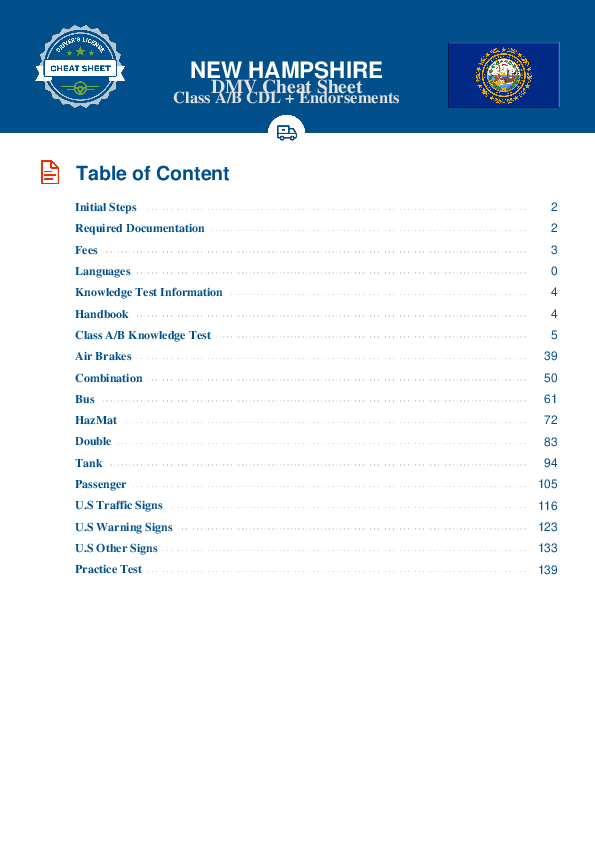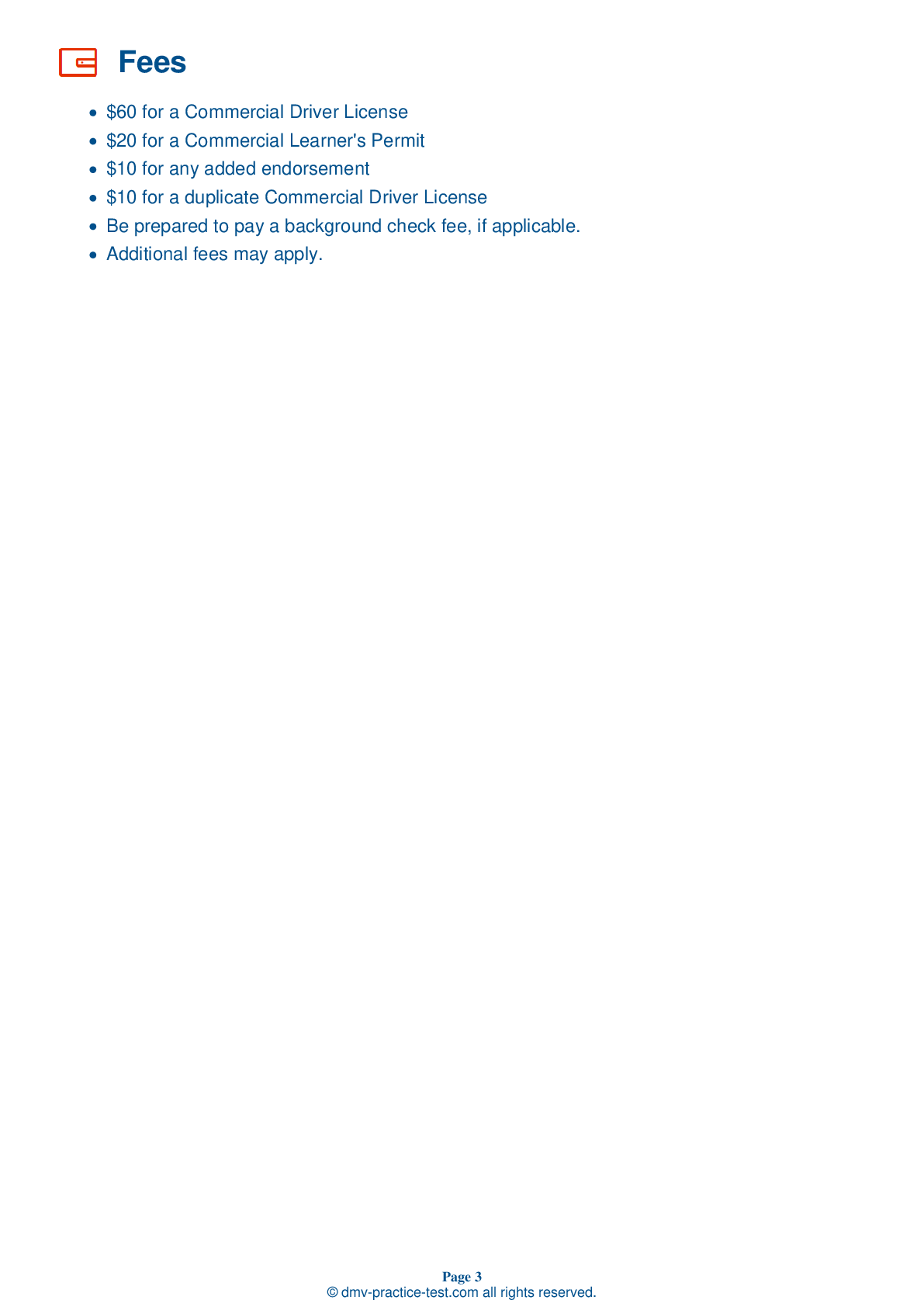Knowledge Test Class A #2
Class A Driving Test | New Hampshire 2025 #2 Page 5 of 7
Train for FREE online with our New Hampshire class A license test. The official exam test consists of several obligatory parts, with all of them checking your knowledge of different blocks of road rules. If you need to obtain a NH CDL class A permit in 2025, practice as much as possible. Free sample tests published on our website will help you check and improve your knowledge and boost your grades. Please bear in mind that CDL class A requirements may vary from state to state.
50
40
20
29 . A serious traffic violation involves each of the following offenses, except:
Following too closely.
Traffic violations classified as "serious" include excessive speeding, reckless driving, operating a CMV without a valid CDL, following other vehicles too closely, and improper lane usage. Consequences for multiple serious traffic violations can result in license disqualification.
30 . What is the minimum permitted size of a placard?
32 square inches
Hazardous materials must be diamond-shaped and a size of at least 10 ¾ square inches.
31 . Which gas would cause concern due to a faulty exhaust system?
A leaking exhaust system can introduce carbon monoxide, which is poisonous, into the cab or sleeper berth.
32 . The leading factor resulting in death and injury in work zones is:
The leading cause of injury and death in roadway work zones is excessive speed by passing drivers. Lower your speed when driving through a work zone.
33 . If your brakes fail on a downgrade, your best hope to stop is:
Hitting a slower vehicle in front of you.
If your brakes fail on a downgrade, your best option is to use an escape ramp. If no escape ramp is available, it is a good idea to look for a different escape route, such as a side road or open field.
34 . When inspecting engine compartment belts during the vehicle inspection test:
The applicant must identify which items are not belt-driven, if any.
When checking the engine compartment during the vehicle inspection test, you must check the power steering, water pump, alternator, and air compressor belts. In addition to cracks and frays, you should check the belts for snugness, allowing up to three-quarters of an inch of play at the center of each belt. If any of these items are not belt-driven, you must identify them and ensure that their components are operating properly, are not damaged or leaking, and are mounted securely.
35 . If you are experiencing an engine fire, you should:
Turn on the heater.
In the event of an engine fire, you should turn off the engine as soon as possible. Do not open the hood unless absolutely necessary. Using a fire extinguisher, shoot foam through the louvers or radiator, or from the vehicle’s underside. If you are unsure of how to treat a fire, wait for firefighters to arrive.
2025 New Hampshire | Frequently Asked Questions
To secure a CDL Doubles/Triples endorsement in New Hampshire, you must already possess a valid CDL. You'll need to pass a written knowledge test specific to doubles/triples operation. Studying the New Hampshire CDL Handbook's section on doubles/triples is recommended. Once you've passed the test, the endorsement will be added to your CDL.
To obtain a CDL Doubles/Triples license, you firstly need to have a valid commercial driver's license (CDL). Next, you will need to pass a knowledge test specific to operating doubles/triples. This test covers topics such as coupling and uncoupling, inspecting doubles and triples, and the proper procedures for pulling double/triple trailers.
While no specific experience is mandated by law for a CDL Doubles/Triples endorsement, it's crucial you're proficient in operating a commercial vehicle. The endorsement requires passing a written knowledge test on handling such vehicles. Training, though not compulsory, can be beneficial for understanding vehicle handling, coupling/uncoupling, and inspection procedures.
Yes, to get a CDL Doubles/Triples endorsement, you must pass a specific written knowledge test. The test covers areas such as coupling and uncoupling, inspecting doubles and triples, and the correct procedures for pulling double/triple trailers. The endorsement does not require a separate skills test.
Actually, for a CDL Doubles/Triples endorsement, you won't need to demonstrate any specific skills or maneuvers in a road test. The endorsement requires only a written knowledge test. This test focuses on areas like coupling and uncoupling, inspecting doubles and triples, and proper procedures for pulling double/triple trailers.
No, it is not permissible. To legally operate double or triple trailers in New Hampshire, you must have a valid Commercial Driver's License (CDL) with a Doubles/Triples endorsement. Operating such vehicles without the proper endorsement can lead to legal penalties, including fines and potential loss of your CDL.
You can add the CDL Doubles/Triples endorsement to your existing CDL. You'll need to pass the Doubles/Triples knowledge test. Once you pass, the endorsement will be added to your CDL. It's not necessary to initiate a completely new application for a CDL unless your current one is not valid.
Yes, there are limitations for drivers with a CDL Doubles/Triples endorsement. One major constraint is that they can only drive double and triple trailers on highways and interstates. They are generally not allowed to drive these large vehicles in residential areas. Also, specific rules about weight and length of the trailers must be adhered to, as per federal and state regulations.
In New Hampshire, the maximum weight for a vehicle with a double/triple trailer is 80,000 pounds. The maximum length of a trailer is 53 feet. However, the combined length of the truck and double trailers cannot exceed 75 feet. For triples, the total length should not exceed 65 feet. It's important to check federal regulations as well, as they may have additional restrictions.
Yes, drivers with a CDL Doubles/Triples endorsement must follow specific safety guidelines. These include checking all connections regularly, maintaining safe following distances, and taking extra care when turning or changing lanes due to the increased length of the vehicle. Additionally, drivers must be aware of the "crack-the-whip" effect that can happen when driving at high speeds or making sudden lane changes.



